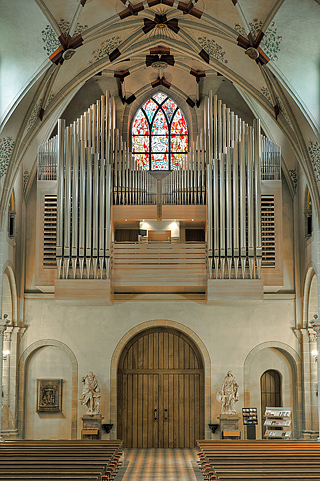 Organ of the Basilika in St. Kastor in Koblenz
Organ of the Basilika in St. Kastor in Koblenz
IV/P/53
Opus 430
Year of construction 2014
Mechanical and electrical key action
Electrical stop action
Combined BUS-System with combination system and Touchscreen-control
Freely selectable coupler system and Midi-controller
Recording and Replay Function
Organ case: oak, white stained
The culturally and historically important basilica of St. Kastor in Koblenz will receive a new pipe organ appropriate for the dignity of its church ambience. The concept of this instrument is a symbiosis of contemporary architecture and the tradition of organ building of over a thousand years.
The design of the organ case stems from the pen of Prof. Ulrich Hahn of the renowned architect office Hahn & Helten of Aachen. Prof. Hahn in cooperation with organ builder Stephan Mayer found it very important to choose the organ proportions in a way that they would not disturb the balance of the church interior architecture and would also maintain the musical and design necessities of organ construction.
The new organ has 4 keyboard sections with a tone volume of 58 notes each and a pedal section with a tone volume of 32 notes. The instrument has 52 stop ranges, distributing into 44 resounding stops with self-sufficient pipe rows, 7 stop pulls and 1 pedal transmission. The stop pulls have 12 pipes each, all other notes are borrowed from the stops of the pedal section. The transmission is a technical fixture which enables the use of the praestant 16’ pipes from the main section without using couplers with the pedals, as well.
The concept of an organ this size with 4 keyboards is very rare. This way, the organist has a very large spectrum of playing options at his disposal to design their musical performance for worship services and concerts at the same token.
Sound-wise the new instrument is oriented at the type of the „symphonic organ“. This means that the organ sound is mainly orchestral: Blending sounds and expressive dynamics portray this organ type. However, with the intonation of the new organ it is equally important to have pronounced individual tone characteristics, as mere sound amplification means a significant impediment of sound diversity.
The pipe section of the organ consists in a total of 3,679 individual pipes. 298 of them are made of mainly oak and fir wood. The metal pipes are made of a tin-lead alloy. 172 of them have a tin content of 82%, 2.763 75% and 446 contain 40% tin. The different pipe materials serve to characterize the sound of the individual stops simply by the choice of materials. The largest organ pipe is visible in the prospectus: it is the C of the stop Principal Bass 16‘ with a total length of 6 m. The smallest pipe is in the register Cymbel III 1‘ with a length of only 5 mm. The deepest note of the organ is the C of the Untersatz 32‘ with a frequency of 16 Hz. This tone level is at the very bottom of the human hearing range. The first 12 pipes of this pedal register are housed in a separate chamber under the attic of the northern Obergarden. The sound gets into the church interior through 2 openings in the northern wall of the main nave to the right of the organ.
The organ casing is made of select oak wood. Natural drying over many years enhances this timber with an extraordinary resilience to seasonal variations. The wood surfaces are glazed in white, which reduces the natural darkening process of the oak wood and imparts an optical lightness to the organ prospect, despite its imposing size, measuring 9 m in width, 7.95 m in height and 2.6 m in depth.
Even though the new organ is based on the mechanical engineering of traditional pipe organ building, it also has very modern electrical playing aids which make the wide-ranging operation of such an instrument considerably easier for the organist. Part of this is a setting section which is operated using a touch screen at the keyboard. The organist can store many different stop combinations required to play different musical pieces in a computer and select them later at the push of a button. Another highlight of the organ is the built-in recording and replay function. This allows the recording of e.g. the play of a concert organist, i.e. the computer will record all functions and stop choices they used, from note sequences up to the control of the swell shutters. This precise recording will be available at your fingertips any time afterwards.
These are only a few reasons why the new organ at St. Kastor’s is a locally and transregionally unique instrument.






